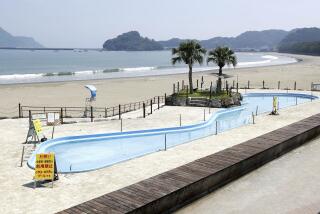A Month After Quake, Prayers and Tax Relief : Japan: The victims of the Kobe disaster are remembered. Bills get speedy, unanimous approval in Parliament.
- Share via
TOKYO — With a silent prayer for the 5,391 dead and its speediest legislation in 44 years, Japan on Friday marked the end of the first month of suffering for victims of Kobe’s killer earthquake and the beginning of budget measures to promote rehabilitation.
Twice during the day--at 5:46 a.m., the moment at which the 6.8-magnitude earthquake struck on Jan. 17, and again at noon--Toshitami Kaihara, governor of Hyogo prefecture, or state, led a one-minute silent prayer.
Kaihara promised to provide temporary housing to those among the 210,000 refugees still living in evacuation centers and, beginning next year, to launch a three-year program to build 100,000 new, permanent housing units.
Meanwhile, the government of Prime Minister Tomiichi Murayama submitted five tax bills to Parliament in the morning and won unanimous approval for three of them in both houses by late afternoon. Not since 1951 had Parliament enacted into law any bill of substance in just one day.
Under the new tax laws, quake victims who suffered property damage will be entitled to exemptions or reductions in national income taxes for 1994 and 1995 and receive the right to claim reductions on local income taxes for up to four years.
Murayama’s Cabinet also approved the outline of a $10.2-billion disaster-relief supplementary budget for fiscal 1994 that officials said they will submit to Parliament next Friday. Another extra spending package will be enacted later as a supplement to the budget for fiscal 1995, which begins April 1.
Kaihara predicted that the exact number of households that need temporary housing will not become known until gas and water services are restored throughout the devastated area.
Many refugees staying in evacuation centers, he predicted, will return to their homes when utilities are restored.
*
Water supplies should be available by the end of this month to the 177,000 households that still lack them, he said.
Osaka Gas Co., which serves the disaster area, said it hopes to restore its service to 562,000 households in the first 10 days of March.
The acute, basic needs of refugees--food, shelter and medical care--seem generally under control.
Symbolizing Japan’s affluence, many of the 1,000 evacuation centers now bulge with relief goods, including clothes, blankets, medicine and toiletries.
While evacuees initially were forced to share one cold rice ball or one banana among two or three people, many of the camps now serve hot meals of rice porridge or stews from steaming pots fired by portable gas canisters. Larger camps are staffed with medical doctors and psychiatrists to help evacuees deal with everything from colds to depression.
“Survival was the main issue the first three weeks, but now we really have to focus on the psychological issues--the depression, emptiness, sense of loss,” said Shigeo Tatsuki, a Kwansei Gakuin University social welfare professor who heads the school’s volunteer network.
Indeed, experts in Kobe say that children are beginning to show signs of post-traumatic stress disorder--which afflicted the Northridge quake victims. Symptoms range from an inability to sleep to a return to infantile behavior.
The plight of the elderly is also raising concerns: At least 115 of them have died from heart attacks, strokes and pneumonia suffered in the cramped and chilly relief camps.
Although the prefecture has announced plans to provide 40,000 temporary housing units, construction of only 649 prefabricated dwellings has been completed to date. Nearly 60,000 households, meanwhile, have applied for temporary housing.
Parks, school playgrounds and government-owned athletic fields have been commandeered to provide space for prefabricated housing units.
But Kaihara said his government still had not come up with enough land to build all of the temporary units that will be needed to house refugees, rent-free, for a maximum of two years.
Japanese media reported that officials were considering turning a massive parking lot for the Orix BlueWave, Kobe’s professional baseball team, into a temporary housing site.
*
Despite the continuing troubles, life in Kobe is slowly returning to normal.
The wail of sirens, ubiquitous emergency vehicles and roaming Self-Defense Forces troops are nearly gone from the streets now. Men in suits going to work and uniformed children walking to school have replaced scenes of bedraggled evacuees clutching suitcases and paper bags filled with their life possessions. Women are wearing makeup and skirts again.
In the Motomachi shopping district, many stores have reopened to bustling business, as disaster sales attract throngs of local shoppers--as well as visitors from nearby cities.
A can-do spirit fills the air, with many stores displaying signs of encouragement: “Let’s do our best, Kobe!”
Murayama’s Cabinet also informally approved an initial portion of a new crisis management plan for the national government.
From now on, helicopters of the Self-Defense Forces will be mobilized immediately to monitor damage any time a disaster occurs without waiting for government instructions. Companies providing gas, water, electricity and other public services will be asked to report damages as quickly as possible to the prime minister’s office.
Watanabe reported from Kobe and Jameson from Tokyo.
More to Read
Sign up for Essential California
The most important California stories and recommendations in your inbox every morning.
You may occasionally receive promotional content from the Los Angeles Times.











